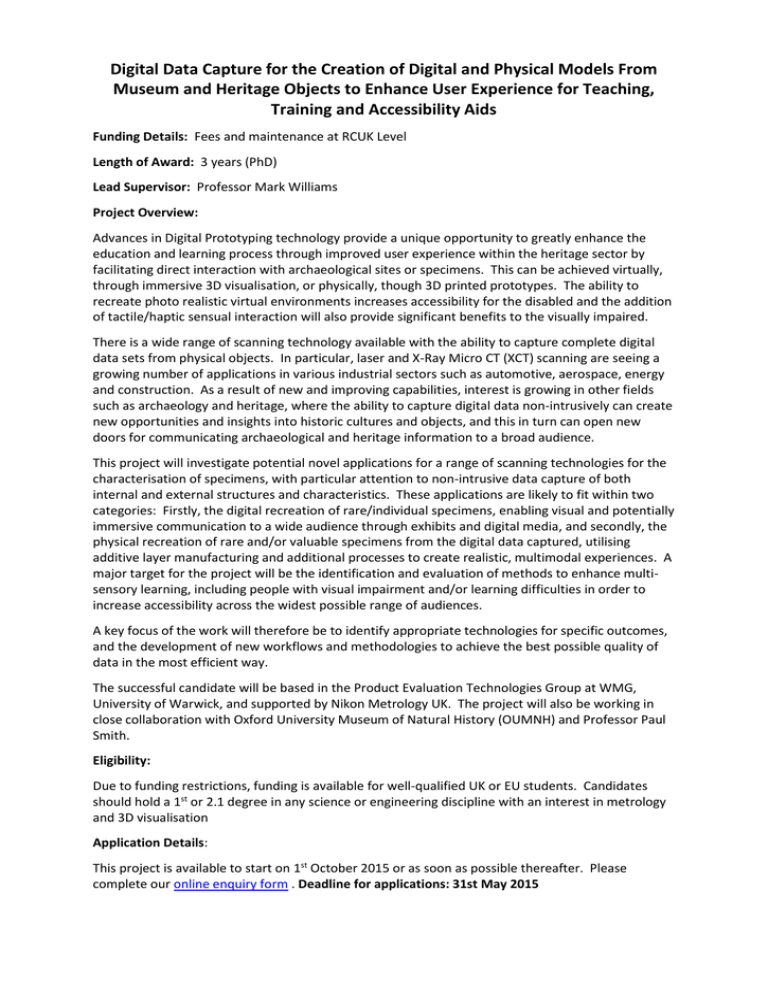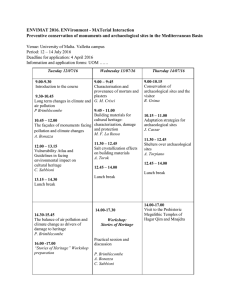Digital Data Capture for the Creation of Digital and Physical... Museum and Heritage Objects to Enhance User Experience for Teaching,
advertisement

Digital Data Capture for the Creation of Digital and Physical Models From Museum and Heritage Objects to Enhance User Experience for Teaching, Training and Accessibility Aids Funding Details: Fees and maintenance at RCUK Level Length of Award: 3 years (PhD) Lead Supervisor: Professor Mark Williams Project Overview: Advances in Digital Prototyping technology provide a unique opportunity to greatly enhance the education and learning process through improved user experience within the heritage sector by facilitating direct interaction with archaeological sites or specimens. This can be achieved virtually, through immersive 3D visualisation, or physically, though 3D printed prototypes. The ability to recreate photo realistic virtual environments increases accessibility for the disabled and the addition of tactile/haptic sensual interaction will also provide significant benefits to the visually impaired. There is a wide range of scanning technology available with the ability to capture complete digital data sets from physical objects. In particular, laser and X-Ray Micro CT (XCT) scanning are seeing a growing number of applications in various industrial sectors such as automotive, aerospace, energy and construction. As a result of new and improving capabilities, interest is growing in other fields such as archaeology and heritage, where the ability to capture digital data non-intrusively can create new opportunities and insights into historic cultures and objects, and this in turn can open new doors for communicating archaeological and heritage information to a broad audience. This project will investigate potential novel applications for a range of scanning technologies for the characterisation of specimens, with particular attention to non-intrusive data capture of both internal and external structures and characteristics. These applications are likely to fit within two categories: Firstly, the digital recreation of rare/individual specimens, enabling visual and potentially immersive communication to a wide audience through exhibits and digital media, and secondly, the physical recreation of rare and/or valuable specimens from the digital data captured, utilising additive layer manufacturing and additional processes to create realistic, multimodal experiences. A major target for the project will be the identification and evaluation of methods to enhance multisensory learning, including people with visual impairment and/or learning difficulties in order to increase accessibility across the widest possible range of audiences. A key focus of the work will therefore be to identify appropriate technologies for specific outcomes, and the development of new workflows and methodologies to achieve the best possible quality of data in the most efficient way. The successful candidate will be based in the Product Evaluation Technologies Group at WMG, University of Warwick, and supported by Nikon Metrology UK. The project will also be working in close collaboration with Oxford University Museum of Natural History (OUMNH) and Professor Paul Smith. Eligibility: Due to funding restrictions, funding is available for well-qualified UK or EU students. Candidates should hold a 1st or 2.1 degree in any science or engineering discipline with an interest in metrology and 3D visualisation Application Details: This project is available to start on 1st October 2015 or as soon as possible thereafter. Please complete our online enquiry form . Deadline for applications: 31st May 2015






